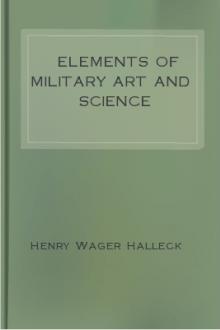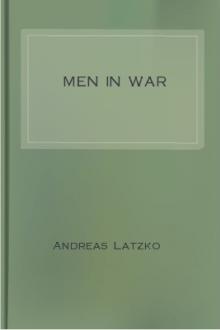Elements of Military Art and Science by Henry Wager Halleck (books you have to read txt) 📕

- Author: Henry Wager Halleck
- Performer: -
Book online «Elements of Military Art and Science by Henry Wager Halleck (books you have to read txt) 📕». Author Henry Wager Halleck
The construction of the Illinois ship-canal, for vessels of eight and a half feet draught, is estimated at fifteen millions; to give the same draught to the Mississippi and lower Illinois, would require at least ten millions more; a ship canal of the corresponding draught around Niagara Falls, will cost, say, ten millions; the navy yard at Memphis, with docks, storehouses, &c., will cost about two millions, and steamers sent thence to the lakes will cost about fifty thousand dollars per gun. On the other hand, the military defences which it is deemed necessary to erect in time of peace for the security of the Champlain frontier, will cost only about two thousand dollars per gun; the whole expenditure not exceeding, at most, two millions of dollars!
It is not to be denied that a water communication between the Mississippi and the northern lakes will have great commercial advantages, and that, in case of a protracted war, auxiliary troops and military stores may be drawn from the valley of the Mississippi to assist the North and East in preventing any great accessions to the British military forces in the Canadas. We speak only of the policy of expending vast sums of money on this military (?) project, to the neglect of matters of more immediate and pressing want. We have nothing to say of its character as a commercial project, or of the ultimate military advantages that might accrue from such a work. We speak only of the present condition and wants of the country, and not of what that condition and those wants may be generations hence!
[28]
There are no books devoted exclusively to the subjects embraced in this chapter; but the reader will find many remarks on the northern frontier defences in the histories of the war of 1812, in congressional reports, (vide House Doc. 206, XXVIth Congress, 2d session; and Senate Doc., No. 85, XXVIIIth Congress, 2d session,) and in numerous pamphlets and essays that have appeared from the press within the last few years.
CHAPTER IX.ARMY ORGANIZATION—STAFF AND ADMINISTRATIVE CORPS.
By the law of the 12th of December, 1790, on the organization of the public force of France, the Army was defined, "A standing force drawn from the public force, and designed to act against external enemies." [Une force habituelle extraite de la force publique, et destinée essentiellement à agir contre les ennemis du dehors.]
In time of peace, the whole organized military force of the State is intended when we speak of the army; but in time of war this force is broken up into two or more fractions, each of which is called an army. These armies are usually named from the particular duty which may be assigned to them—as, army of invasion, army of occupation, army of observation, army of reserve, &c.; or from the country or direction in which they operate—as, army of the North, of the South, of Mexico, of Canada, of the Rhine, &c.; or from the general who commands it—as, the army of Soult, army of Wellington, army of Blücher, &c.
All modern armies are organized on the same basis. They are made up of a Staff and Administrative departments, and four distinct arms—Infantry, Cavalry, Artillery, and Engineers; each having distinct duties, but all combining to form one and the same military body. In the actual operations of a campaign, these forces are formed into corps d'armée, each corps d'armée being composed of two or more grand-divisions; each grand-division, of two or more brigades; and each brigade, of several companies, squadrons, or batteries.
In speaking of an army in the field, it is sometimes supposed to be divided into two classes of men—the Staff and the line. We here include in the first class—
All officers, of whatever arm, above the rank of colonel;
All officers of the staff corps of whatever grade, and
All officers attached to the staff as aides, &c.;
All officers of the administrative departments;
All officers of artillery and engineer staffs;
The corps of geographical or topographical engineers, and
The guards.
In the second class are included all troops, of whatever arm, which belong to the active army, in infantry, cavalry, artillery, and engineers. All troops on detached service, such as recruiting, guarding posts and dépôts, escorting convoys, &c., as well as all sedentary corps, garrisons of fortified places, &c., are not regarded in this classification as composing any part of the line of the army.
Troops of the line is a term applied only to such troops as form the principal line on the battle-field, viz:—The heavy infantry and heavy cavalry. These are technically called infantry of the line, and cavalry of the line. In this sense of the term, light infantry, light cavalry or dragoons, artillery, and engineers, are not classed as troops of the line. But this distinction is now pretty much fallen into disuse, and the division of an army into Staff and Administrative departments, and four arms of service—Infantry, Cavalry, Artillery, and Engineers—is now regarded as the most convenient, from being precise and definite in its meaning.
The general staff of an army includes all general officers of the army, and such officers of lower grades as are attached to this general duty, instead of serving with troops, or on special administrative duty. The general officers are—1st, the generalissimo, or commander-in -chief; 2d, generals, or marshals, as they are called in France, or field-marshals and generals of infantry and cavalry, as they are called in England and the northern states of Europe; 3d, lieutenant-generals; 4th, generals of division, or major-generals, as they are called in England; 5th, generals of brigade, or brigadier-generals, as they are sometimes called;—colonels, majors, captains, lieutenants, ensigns, and cornets or cadets, are also either attached to the staff, or form a part of the staff corps. The titles of "adjutant-general," and of "inspector-general," are given to staff officers selected for these special services, either in the general staff or in the several corps d'armée. No special rank is attached to these offices themselves, and the grade of those who hold them is fixed by some special rule, or by their general rank in the army.
In the war of the Revolution, Washington held the rank of General, and in 1798 the rank of Lieutenant-general. In the war of 1812, the highest grade held by any of our officers was that of General of Division, or Major-general, as it was called. The highest grade in our army at the present time is called Major-general—a title that properly belongs, not to the general of an army, but to the chief of staff. Hamilton had this title when chief of Washington's staff; Berthier and Soult when chief of Napoleon's staff, the former till the close of the campaign of 1814, and the latter in the Waterloo campaign. General Jomini first greatly distinguished himself as chief of Ney's staff, and afterwards on the staff of the Emperor of Russia. Other generals have owed much of their success to the chiefs of their staff:—Pichegru to Regnier, Moreau to Dessoles, Kutusof to Toll, Barclay to Diebitsch, and Blücher to Sharnharst and Gneisenau.
The generalissimo or commander-in-chief of an army is the person designated by the law of the land to take charge of the organized military forces of the state. In this country the President, through his Secretary of War, exercises this general command. In England, Wellington acts in the capacity of commander-in-chief of all the British military forces. In France, the Minister of War, under the king, has this general direction. In other European services, some prince of the blood, or distinguished general, exercises the functions of generalissimo.
An active army in the field should be commanded by a general, or, as is done in some European countries, by a marshal. These may be regarded as of assimilated rank.
A corps d'armée should, be commanded by a Lieutenant-general. This rule is almost universal in Europe. The number of marshals in France under Napoleon was so great, that officers of this grade were often assigned to corps d'armée.
A grand division of an army should be commanded by a General of Division. In England, the assimilated grade is that of major-general, and in France at the present time, the younger lieutenant-generals, or the maréchaux-de-camp, command divisions.
A brigade should be commanded by a Brigadier-general. At the present time in the French service, maréchaux-de-camp act as commanders of brigades.
The several corps d'armée are designated by numbers, 1st, 2d, 3d, &c., and in the same way the several divisions in each corps d'armée, and the several brigades in each division.
When the number of troops are placed on a war footing, each corps d'armée ordinarily contains from twenty to thirty thousand men.
The command of these several corps d'armée, divisions, and brigades, is taken by the officers of the corresponding grades according to seniority of rank, and without reference to arms, unless otherwise directed by the generalissimo, who should always have the power to designate officers for special commands.
The chief of staff of an army is usually selected from the grade next below that of the general commanding, and receives the title, for the time being, which is used to designate this special rank. In some European armies, and formerly in our own service, this officer was called major-general. In France, if the generalissimo commands in person, a marshal is made chief of staff with the temporary title of major-général; but if a marshal commands the army, a lieutenant -general or maréchal-de-camp becomes chief of staff with the title of aide-major-général. The chiefs of staff of corps d'armée and of divisions, are selected in precisely the same way.
The position assigned by the commanding general for the residence of his staff, is denominated the General Head-Quarter of the army; that of a corps d'armée staff, the Head-Quarters of [1st or 2d, &c.] corps d'armée; that of a division, the Head-Quarters of [1st or 2d, &c.] division, [1st or 2d, &c.] corps d'armée.
The petty staffs of regiments, squadrons, &c., consisting of an adjutant, sergeant-major, &c., are especially organized by the commandants of the regiments, &c., and have no connection whatever with the general staff of an army. Of course, then, they are not embraced in the present discussion.
The subordinate officers of the staff of an army, in time of war, are charged with important and responsible duties connected with the execution of the orders of their respective chiefs. But in time of peace, they are too apt to degenerate into fourth-rate clerks of the Adjutant-general's department, and mere military dandies, employing their time in discussing the most unimportant and really contemptible points of military etiquette, or criticising the letters and dispatches of superior officers, to see whether the wording of the report or the folding of the letter exactly corresponds to the particular regulation applicable to the case. Such was the character given to the first staff of Wellington, and a similar class of men composed the staff of the army of Italy when it was abolished by Napoleon and a new one formed in its place. There are also some officers of this stamp in our own service, but they are regarded by the army with universal contempt. The staff of our army requires a new and different organization, and should be considerably enlarged.
The following is the composition of a regularly organized general staff in the French service, for an army of forty or fifty thousand men divided into two corps d'armée and a reserve.
1st. The marshal (or general) commanding-in-chief; and one colonel or lieutenant-colonel, one major, three captains and three subalterns, as aides-de-camp.
2d. A lieutenant-general as chief-of-staff, with the title of major-general, assisted by one colonel or lieutenant-colonel, three majors, five captains, and one subaltern, as aides-de-camp.
3d. Three lieutenant-generals, commanding the corps d'armée and reserve. Each of these will be assisted by aides in the same way as the major-general, and each will also have his regularly-organized staff of corps d'armée, with a general of division or general of brigade as chief.
4th. Six or nine generals commanding





Comments (0)